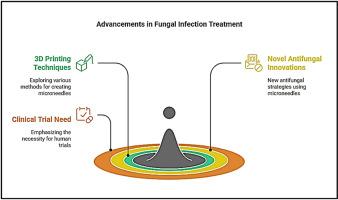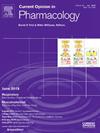用于抗真菌治疗的3d打印透皮微针贴片的进展:现状和挑战
IF 4.2
3区 医学
Q1 PHARMACOLOGY & PHARMACY
引用次数: 0
摘要
皮肤真菌感染和全身真菌感染非常普遍,造成重大的医疗负担。针对真菌感染的普遍性和有时危及生命的性质,已经刺激了对新治疗策略的广泛研究,特别是关注有效的药物配方和创新的给药途径。其中,使用微针(MNs)的透皮给药(TDD)是一种很有前途的方法。3d打印MN贴片由微小的针状结构阵列组成,旨在通过破坏角质层来促进治疗剂的输送。利用3D打印的精度和改进的纳米颗粒的药物输送,3D打印透皮纳米颗粒提供了一种很有前途的治疗真菌感染的方法。这篇综述全面分析了最近关于3d打印MNs用于抗真菌治疗的文献,强调了制造方法、药物掺入技术和临床前评估结果的进展。此外,该研究还介绍了通过透皮贴片施用抗真菌剂的各种新颖创新,证明了它们比传统方法的有效性和优越性。大多数研究都是体外实验研究,强调了将3d打印的mn基TDD转化为临床实践的人体试验的必要性。这一发现强调了3d打印微针贴片在转化透皮抗真菌治疗方面的前景;然而,广泛的临床验证对于监管认可和实际实施仍然至关重要。本文章由计算机程序翻译,如有差异,请以英文原文为准。

Advances in 3D-printed transdermal microneedle patches for antifungal therapy: Current scenario and challenges
Skin fungal infection and systemic fungal infections are highly prevalent, causing significant healthcare burden. Addressing the pervasive and sometimes life-threatening nature of fungal infections has spurred extensive research into novel therapeutic strategies, particularly focusing on effective drug formulations and innovative delivery routes. Among this transdermal drug delivery (TDD) using microneedles (MNs) is a promising approach. 3D-printed MN patches are composed of arrays of tiny, needle-like structures engineered to facilitate the delivery of therapeutic agents by breaching the stratum corneum. Using the precision of 3D printing and improved drug delivery of MNs, 3D-printed transdermal MNs present a promising approach to manage fungal infections. This review provides a comprehensive analysis of recent literature on the use of 3D-printed MNs for antifungal therapy, emphasizing advancements in fabrication methods, drug incorporation techniques, and preclinical assessment outcomes. Furthermore, the study informs on various novel innovations employing antifungal agent administered through transdermal patches, demonstrating their efficacy and superiority over traditional methods. The majority of the studies are in vitro experimental studies, highlighting the need for human trials to translate 3D-printed MN-based TDD into clinical practice. The findings highlight the promise of 3D-printed microneedle patches in transforming transdermal antifungal therapy; however, extensive clinical validation remains crucial for regulatory endorsement and practical implementation.
求助全文
通过发布文献求助,成功后即可免费获取论文全文。
去求助
来源期刊
CiteScore
8.80
自引率
2.50%
发文量
131
审稿时长
4-8 weeks
期刊介绍:
Current Opinion in Pharmacology (COPHAR) publishes authoritative, comprehensive, and systematic reviews. COPHAR helps specialists keep up to date with a clear and readable synthesis on current advances in pharmacology and drug discovery. Expert authors annotate the most interesting papers from the expanding volume of information published today, saving valuable time and giving the reader insight on areas of importance.

 求助内容:
求助内容: 应助结果提醒方式:
应助结果提醒方式:


